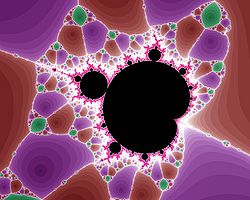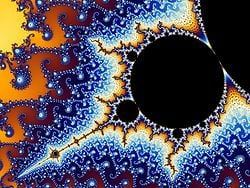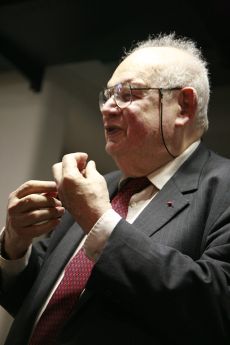Benoit Mandelbrot
| Benoît Mandelbrot | |
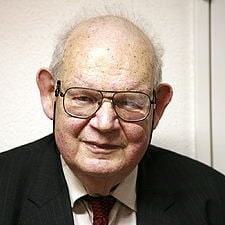 Mandelbrot in 2007
| |
| Born | November 20 1924 Warsaw, Poland |
|---|---|
| Died | 14 October 2010 (aged 85) Cambridge, Massachusetts, United States |
| Residence | Poland, France, United States |
| Nationality | Polish, French, American |
| Fields | Mathematics, Aerodynamics |
| Institutions | Yale University International Business Machines (IBM) Pacific Northwest National Laboratory |
| Alma mater | École Polytechnique California Institute of Technology University of Paris |
| Doctoral advisor | Paul Lévy |
| Doctoral students | Laurent Calvet Eugene Fama Ken Musgrave Murad Taqqu Daniel Zajdenweber |
| Known for | Mandelbrot set Fractals Chaos Theory Zipf–Mandelbrot law |
| Influences | Johannes Kepler |
| Notable awards | Harvey Prize (1989) Wolf Prize (1993) Japan Prize (2003) Franklin Medal Légion d'honneur |
| Spouse | Aliette Kagan (1955–2010, his death) |
Benoît B. Mandelbrot (November 20, 1924 – October 14, 2010) was a Polish-born, French and American mathematician, noted for developing a "theory of roughness" in nature and the field of fractal geometry to help prove it. He is best known for coining the term "fractal," and for discovering the Mandelbrot set of intricate, never-ending fractal shapes, named in his honor.
Mandelbrot was one of the first to use computer graphics to create and display fractal geometric images, leading to his discovering the Mandelbrot set in 1979. In so doing, he was able to show how visual complexity can be created from simple rules. His innovative work with computer graphics stimulated the use of computers in mathematics in a whole new way.
Considered a maverick whose work belonged to no particular academic field, Mandelbrot's work contributed to such diverse fields as geology, medicine, cosmology, engineering, and the social sciences: Fractals have been used to describe diverse behavior in areas including economics, finance, the stock market, and astronomy.
An even greater contribution he made to human society, however, may be in showing that geometrical forms found in nature have incredible beauty.
Life
Benoit Mandelbrot was born on November 20, 1924 in Warsaw, Poland, to a family from Lithuania. His family had a strong academic tradition, his mother was a medical professional and he was tutored by his intellectual uncle.[1] He also noted that his “father was a map nut. From him, I learned to read maps before I could read and write.”[2]
The family emigrated from Poland to France in 1936 when he was 11. There he was introduced to mathematics by another uncle, his father's younger brother Szolem Mandelbrojt, who was a mathematician residing in Paris: "The love of his mind was mathematics," Mandelbrot wrote in his autobiography.[3] "The fact that my parents, as economic and political refugees, joined Szolem in France saved our lives."[3][4]
Mandelbrot attended the Lycée Rolin in Paris until the start of World War II, when his family then moved to Tulle, France. He was helped by Rabbi David Feuerwerker, the Rabbi of Brive-la-Gaillarde, to continue his studies.[5] Much of France was occupied by the Nazis at the time, and Mandelbrot recalls this period:
Our constant fear was that a sufficiently determined foe might report us to an authority and we would be sent to our deaths. This happened to a close friend from Paris, Zina Morhange, a physician in a nearby county seat. Simply to eliminate the competition, another physician denounced her.... We escaped this fate. Who knows why?[3]
In 1944, Mandelbrot returned to Paris, studied at the Lycée du Parc in Lyon, and in 1945 to 1947 attended the École Polytechnique, where he studied under Gaston Julia and Paul Lévy. From 1947 to 1949 he studied at California Institute of Technology, where he earned a master's degree in aeronautics.[6] Returning to France, he obtained his PhD degree in Mathematical Sciences at the University of Paris in 1952.[1]
From 1949 to 1958, Mandelbrot was a staff member at the Centre National de la Recherche Scientifique. During this time he spent a year at the Princeton University Institute for Advanced Study, where he was sponsored by John von Neumann. In 1955 he married Aliette Kagan and moved to Geneva, Switzerland, and later to the Université Lille Nord de France.[7] In 1958 the couple moved to the United States where Mandelbrot joined the research staff at the IBM Thomas J. Watson Research Center in Yorktown Heights, New York.[7] He remained at IBM for 35 years, becoming an IBM Fellow, the highest honor a scientist, engineer, or programmer at IBM can achieve, and later Fellow Emeritus.[1]
Mandelbrot left IBM in 1987 when they decided to end pure research in his division.[8]
He then joined the Department of Mathematics at Yale University. In 1999 he obtained his first tenured post as Sterling Professor of Mathematical Sciences at the age of 75, the oldest professor in Yale's history to receive tenure.[9] He retired from Yale in 2005.
Mandelbrot died in a hospice in Cambridge, Massachusetts, on October 14, 2010 from pancreatic cancer, at the age of 85.[10][11]
Work
Having studied Mathematics in France and aeronautics in California, Mandelbrot spent most of his career in both the U.S. and France, having dual French and American citizenship. His most significant work, and that for which he is most famous, was in the study of fractals. A fractal is a natural phenomena and a mathematical set. Mandelbrot used computer graphics to create and display fractal geometric images, leading to his discovering the mathematical set named after him: the Mandelbrot set.
Mandelbrot's research took him beyond the field of mathematics. He worked on problems and published papers in applied fields such as information theory, economics, and fluid dynamics. For example, in his research in economics, he found that price changes in financial markets did not follow a Gaussian distribution, but rather Lévy stable distributions having theoretically infinite variance. "Stable" distributions have the property that the sum of many instances of a random variable follows the same distribution but with a larger scale parameter.[12]
"Fractal geometry" and the Mandelbrot set
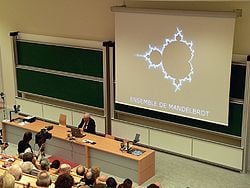
Mandelbrot was the first to use the term "fractal," based on the Latin fractus meaning "broken" or "fractured." He used it to extend the concept of theoretical fractional dimensions to geometric patterns in nature.[13][14]
The mathematical roots of the idea of fractals have been traced throughout the years as a formal path of published works, starting in the seventeenth century with notions of recursion, then moving through increasingly rigorous mathematical treatment of the concept to the study of continuous but not differentiable functions in the nineteenth century.
Stephen Wolfram described fractals as a form of geometric repetition: "in which smaller and smaller copies of a pattern are successively nested inside each other, so that the same intricate shapes appear no matter how much you zoom in to the whole. Fern leaves and Romanesco broccoli are two examples from nature."[15] He points out an unexpected conclusion:
One might have thought that such a simple and fundamental form of regularity would have been studied for hundreds, if not thousands, of years. But it was not. In fact, it rose to prominence only over the past 30 or so years—almost entirely through the efforts of one man, the mathematician Benoit Mandelbrot.[15]
In 1975 Mandelbrot coined the word "fractal" and illustrated his mathematical definition with striking computer-constructed visualizations.[14] Building on previous work by Gaston Julia and Pierre Fatou, Mandelbrot used the newly developed IBM computers at his disposal to plot images of the Julia sets using computer graphics. While investigating the topology of these Julia sets, he studied the Mandelbrot set fractal that is now named after him. These images captured the popular imagination; many of them were based on recursion, leading to the popular meaning of the term "fractal."[16] In these images Mandelbrot was able to show how visual complexity can be created from simple rules. He said that things typically considered to be "rough," a "mess," or "chaotic," like clouds or shorelines, actually had a "degree of order."[15]
Mandelbrot first published his ideas in his book entitled Fractals: Form, Chance and Dimension.[17] The book was a "breakthrough" for Mandelbrot, who until then would typically "apply fairly straightforward mathematics ... to areas that had barely seen the light of serious mathematics before."[15] Wolfram adds that as a result of this new research, Mandelbrot was no longer a "wandering scientist," and earned the name "the father of fractals":
Mandelbrot ended up doing a great piece of science and identifying a much stronger and more fundamental idea—put simply, that there are some geometric shapes, which he called "fractals", that are equally "rough" at all scales. No matter how close you look, they never get simpler, much as the section of a rocky coastline you can see at your feet looks just as jagged as the stretch you can see from space.[15]
Mandelbrot's fractal images have been described as looking like "the delirious exuberance of the 1960s psychedelic art with forms hauntingly reminiscent of nature and the human body."[2]
He never felt he was inventing a new idea. Mandelbrot described his feelings in a documentary with science writer Arthur C. Clarke:
Exploring this set I certainly never had the feeling of invention. I never had the feeling that my imagination was rich enough to invent all those extraordinary things on discovering them. They were there, even though nobody had seen them before. It's marvelous, a very simple formula explains all these very complicated things. So the goal of science is starting with a mess, and explaining it with a simple formula, a kind of dream of science.[18]
According to Clarke, "the Mandelbrot set is indeed one of the most astonishing discoveries in the entire history of mathematics. Who could have dreamed that such an incredibly simple equation could have generated images of literally infinite complexity?" Clarke also notes an odd coincidence:
The name Mandelbrot, and the word "mandala"—for a religious symbol—which I'm sure is a pure coincidence, but indeed the Mandelbrot set does seem to contain an enormous number of mandalas.[18]
In 1982, Mandelbrot expanded and updated his ideas in The Fractal Geometry of Nature.[13] This influential work brought fractals into the mainstream of professional and popular mathematics, as well as silencing critics, who had dismissed fractals as "program artifacts."
The "theory of roughness"
Mandelbrot created the first-ever "theory of roughness." He saw "roughness" in the shapes of mountains, coastlines and river basins; the structures of plants, blood vessels and lungs; the clustering of galaxies. His personal quest was to create some mathematical formula to measure the overall "roughness" of such objects in nature.[3] He began by asking himself various kinds of questions related to nature:
Can geometry deliver what the Greek root of its name [geo-] seemed to promise—truthful measurement, not only of cultivated fields along the Nile River but also of untamed Earth?[3]
Mandelbrot emphasized the use of fractals as realistic and useful models for describing many "rough" phenomena in the real world. He concluded that "real roughness is often fractal and can be measured."[3] Although Mandelbrot coined the term "fractal", some of the mathematical objects he presented in The Fractal Geometry of Nature had been previously described by other mathematicians. Before Mandelbrot, however, they were regarded as isolated curiosities with unnatural and non-intuitive properties. Mandelbrot brought these objects together for the first time and turned them into essential tools for the long-stalled effort to extend the scope of science to explaining non-smooth, "rough" objects in the real world. His methods of research were both old and new:
The form of geometry I increasingly favored is the oldest, most concrete, and most inclusive, specifically empowered by the eye and helped by the hand and, today, also by the computer ... bringing an element of unity to the worlds of knowing and feeling ... and, unwittingly, as a bonus, for the purpose of creating beauty.[3]
Fractals are also found in human pursuits, such as music, painting, architecture, and stock market prices. Mandelbrot believed that fractals, far from being unnatural, were in many ways more intuitive and natural than the artificially smooth objects of traditional Euclidean geometry:
Clouds are not spheres, mountains are not cones, coastlines are not circles, and bark is not smooth, nor does lightning travel in a straight line.[13]
Mandelbrot also put this idea to work in cosmology. In 1974 he offered an explanation of Olbers' paradox (the "dark night sky" riddle), demonstrating the consequences of fractal theory as a sufficient, but not necessary, resolution of the paradox. He postulated that if the stars in the universe were fractally distributed (for example, like Cantor dust), it would not be necessary to rely on the Big Bang theory to explain the paradox. His model would not rule out a Big Bang, but would allow for a dark sky even if the Big Bang had not occurred.[19]
Awards and honors
Mandelbrot's awards include the Wolf Prize for Physics in 1993, the Lewis Fry Richardson Prize of the European Geophysical Society in 2000, the Japan Prize in 2003, and the Einstein Lectureship of the American Mathematical Society in 2006.
In November 1990, he was made a Knight in the French Légion d'honneur (Legion of Honor); he was promoted to Officer of the Legion of Honor in January 2006.[20]
In December 2005, Mandelbrot was appointed to the position of Battelle Fellow at the Pacific Northwest National Laboratory.[21]
An honorary degree from Johns Hopkins University was bestowed on Mandelbrot in the May 2010 commencement exercises.[22]
The small asteroid 27500 Mandelbrot, discovered on April 12, 2000, was named in his honor.
Legacy
Mandelbrot has been called a visionary and often called himself a maverick.[1] His informal and passionate style of writing and his emphasis on visual and geometric intuition (supported by the inclusion of numerous illustrations) made The Fractal Geometry of Nature accessible to non-specialists. The book sparked widespread popular interest in fractals and contributed to chaos theory and other fields of science and mathematics.
Reacting to news of his death, mathematician Heinz-Otto Peitgen said "if we talk about impact inside mathematics, and applications in the sciences, he is one of the most important figures of the last 50 years."[10]
The President of France at the time of Mandelbrot's death, Nicolas Sarkozy, said Mandelbrot had "a powerful, original mind that never shied away from innovating and shattering preconceived notions". Sarkozy also added, "His work, developed entirely outside mainstream research, led to modern information theory."[23] Mandelbrot's obituary in The Economist points out his fame as "celebrity beyond the academy" and lauds him as the "father of fractal geometry."[24]
His autobiography, The Fractalist, was published in 2012.
Major works
- Mandelbrot, Benoit B. Fractals: Form, Chance and Dimension. W. H. Freeman & Company, 1977. ISBN 978-0716704737
- Mandelbrot, Benoit B. The Fractal Geometry of Nature. W. H. Freeman and Company, 1982. ISBN 978-0716711865
- Mandelbrot, Benoit B. Fractals and Scaling in Finance: Discontinuity, Concentration, Risk. Springer, 1997. ISBN 978-0387983639
- Mandelbrot, Benoit B., and Richard L. Hudson. The (Mis)Behavior of Markets: A Fractal View of Risk, Ruin, and Reward. Basic Books, 2004. ISBN 978-0465043552
- Mandelbrot, Benoit B. Fractals and Chaos: The Mandelbrot Set and Beyond. Springer, 2004. ISBN 978-0387201580
- Mandelbrot, Benoit B. The Fractalist: Memoir of a Scientific Maverick. Random House, 2012. ISBN 978-0307389916
Notes
- ↑ 1.0 1.1 1.2 1.3 Benoit B. Mandelbrot, A maverick's apprenticeship The Wolf Prizes for Physics (Imperial College Press, 2002). Retrieved June 10, 2014.
- ↑ 2.0 2.1 Benjamin Ivry, Benoit Mandelbrot Influenced Art and Mathematics, Forward, November 17, 2012. Retrieved June 11, 2014.
- ↑ 3.0 3.1 3.2 3.3 3.4 3.5 3.6 Benoit Mandelbrot, The Fractalist: Memoir of a Scientific Maverick (Random House, 2012, ISBN 978-0307389916).
- ↑ 'Fractal' mathematician Benoît Mandelbrot dies aged 85 BBC News, October 17, 2010. Retrieved June 10, 2014.
- ↑ Priya Hemenway, Divine Proportion: Phi in Art, Nature, and Science (Sterling, 2005, ISBN 978-1402735226).
- ↑ Nigel Lesmoir-Gordon, Benoît Mandelbrot obituary The Guardian, October 17, 2010. Retrieved June 10, 2014.
- ↑ 7.0 7.1 Anthony Barcellos, Interview of B. B. Mandelbrot Mathematical People, Birkhaüser, 1984. Retrieved June 10, 2014.
- ↑ Benoit Mandelbrot, IBM: background and policies Web of Stories. Retrieved June 10, 2014.
- ↑ Edward Tenner, Benoît Mandelbrot the Maverick, 1924–2010 The Atlantic, October 16, 2010. Retrieved June 10, 2014.
- ↑ 10.0 10.1 Jascha Hoffman, Benoît Mandelbrot, Novel Mathematician, Dies at 85 The New York Times, October 16, 2010. Retrieved June 10, 2014.
- ↑ Benoît Mandelbrot, fractals pioneer, dies United Press International, October 16, 2010. Retrieved June 10, 2014.
- ↑ John Casti, Flight over Wall St New Scientist, April 19, 1997. Retrieved June 11, 2014.
- ↑ 13.0 13.1 13.2 Benoit Mandelbrot, The Fractal Geometry of Nature (W. H. Freeman and Company, 1982, ISBN 978-0716711865).
- ↑ 14.0 14.1 Donald J. Albers and Gerald L. Alexanderson (eds.), Mathematical People: Profiles and Interviews (A. K. Peters, 2008, ISBN 978-1568813400).
- ↑ 15.0 15.1 15.2 15.3 15.4 Stephen Wolfram, The Father of Fractals, Wall Street Journal, November 22, 2012. Retrieved June 11, 2014.
- ↑ John C. Russ, Fractal Surfaces (Plenum Press, 1994, ISBN 978-0306447020).
- ↑ Benoît Mandelbrot, Fractals: Form, Chance and Dimension (W. H. Freeman and Co, 1977, ISBN 978-0716704737).
- ↑ 18.0 18.1 Arthur C. Clarke, Arthur C Clarke – Fractals – The Colors Of Infinity, video interviews, 54 min, YouTube. Retrieved June 11, 2014.
- ↑ Amanda Gefter, Galaxy Map Hints at Fractal Universe New Scientist, June 25, 2008. Retrieved June 11, 2014.
- ↑ Décret du 31 décembre 2005 portant promotion et nomination Legifrance.gouv.fr. Retrieved June 11, 2014.
- ↑ Legendary mathematician joins national laboratory PNNL News Center, February 16, 2006. Retrieved June 11, 2014.
- ↑ Greg Rienzi, Six granted honorary degrees, Society of Scholars inductees recognized The JHU Gazette, June 7, 2010. Retrieved June 11, 2014.
- ↑ Sarkozy rend hommage à Mandelbrot (Sarkozy pays homage to Mandelbrot) Le Figaro, October 16, 2014. Retrieved June 11, 2014.
- ↑ Benoît Mandelbrot, father of fractal geometry, died on October 14th, aged 85 The Economist, October 21, 2010. Retrieved June 11, 2014.
ReferencesISBN links support NWE through referral fees
- Albers, Donald J., and Gerald L. Alexanderson (eds.). Mathematical People: Profiles and Interviews. A. K. Peters, 2008. ISBN 978-1568813400
- Frame, Michael. Benoit Mandelbrot: A Life in Many Dimensions. World Scientific Publishing Company, 2014. ISBN 978-9814366069
- Hemenway, Priya. Divine Proportion: Phi in Art, Nature, and Science. Sterling, 2005. ISBN 978-1402735226
- Mandelbrot, Benoit B. "A Multifractal Walk down Wall Street." Scientific American 280(2) (1999): 70-73.
- Mandelbrot, Benoit B., and Edward Lorenz. Fractals: An Animated Discussion (63 min video film, interviews with Benoît Mandelbrot and Edward Lorenz, computer animations). Films for the Humanities & Sciences, 1997. ISBN 978-0736505208
- Russ, John C. Fractal Surfaces. Plenum Press, 1994. ISBN 978-0306447020
- Samuel, Nina (ed.). The Islands of Benoit Mandelbrot: Fractals, Chaos, and the Materiality of Thinking. Bard Center, 2012. ISBN 978-0300186437
External links
All links retrieved September 28, 2023.
- Mandelbrot's page at Yale
- Benoît Mandelbrot tells his life story (video) on Web of Stories
- Interview with Benoît Mandelbrot (January 1, 1981, Ithaca, NY), Eugene Dynkin Collection of Mathematics Interviews, Cornell University Library.
- Video fly through of an animated Mandelbulb world
- "Hunting the Hidden Dimension", NOVA, Aired August 24, 2011 on PBS.
Credits
New World Encyclopedia writers and editors rewrote and completed the Wikipedia article in accordance with New World Encyclopedia standards. This article abides by terms of the Creative Commons CC-by-sa 3.0 License (CC-by-sa), which may be used and disseminated with proper attribution. Credit is due under the terms of this license that can reference both the New World Encyclopedia contributors and the selfless volunteer contributors of the Wikimedia Foundation. To cite this article click here for a list of acceptable citing formats.The history of earlier contributions by wikipedians is accessible to researchers here:
The history of this article since it was imported to New World Encyclopedia:
Note: Some restrictions may apply to use of individual images which are separately licensed.
